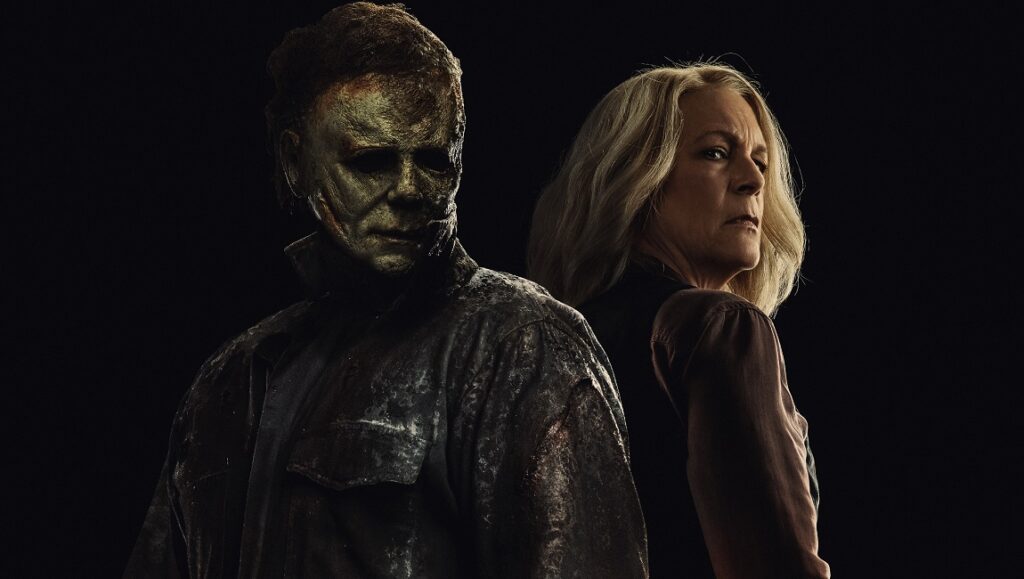Halloween Ends is a superior to film to Halloween Kills, and that’s essentially where the praise ends.
Let’s be clear about one thing right off the bat: the capper to writer-director David Gordon Green’s modern-day Michael Myers trilogy, Halloween Ends, is better than previous installment Halloween Kills, though that’s largely because following up that film with an even worse one would have taken a herculean effort (or… lack of effort?). Unfortunately, beyond that easy win, Halloween Ends is essentially the definition of watchable without ever rising to the rank of good, a silly and rather stupid take on the lore of urban legends and evil that isn’t nearly as novel or clever as it thinks it is, mainly because Green never met a thematic dead horse he couldn’t beat to a bloody pulp.
Picking up four years after the events of Kills — minus a prologue that will be addressed momentarily — Ends finds the citizens of Haddonfield trying to pick up the pieces after serial killer Michael Myers left their community in bloody ruins, with perennial Final Girl Laurie Strode (Jamie Lee Curtis) finally attempting something resembling a normal life, which entails inhabiting a suburban home with orphaned granddaughter Allyson (Andi Matichak) while writing a first-person novel on her experiences and also baking pumpkin pies. Meanwhile, back in pre-credits 2018, we witness as dorky babysitter Corey (Rohan Campbell) accidentally kills his young charge because the kid is a little shit and really shouldn’t be fucking around with locked doors in houses that apparently contain five stories. Corey receives probation but is nonetheless regarded as a psycho, which his mother claims is a result of Michael going missing, as the people need someone to take on the mantle of monster.
Halloween Ends is, of course, a portrait of evil, but also of the various — wait for it — shapes it can take. You see, Michael was originally known as The Shape, because Green loves lording his fandom over any viewer who dares seek potential entertainment. Subsequently, it takes over 40 minutes for Michael Myers to make his initial appearance in Ends, and this is solely so that he can transfer his evil onto Corey, who is so beaten and belittled by his fellow townsfolk on a daily basis that he somewhat understandably comes to see Michael’s power as intoxicating. Thematically, Green isn’t up to anything particularly interesting here, as his entire trilogy has been about the various ways that evil can corrupt individuals caught in its wake, from Laurie to Allyson to each and every “Evil dies tonight!”-spouting townsperson. But Ends makes this connection quite literal, and that’s what marks this entry as more compelling than the director’s past two. Most of the runtime is spent figuring out where the film is headed in regards to the whole Corey/Michael thing, although once we finally reach our destination it’s merely once again a one-on-one confrontation between Laurie and Michael, because apparently we need that, now more than ever.
If anything, Ends feels a bit like a bait-and-switch, something akin to Friday the 13th Part V: A New Beginning, where instead of Jason, we got Roy. Ladies and gentlemen, may I present the new face of Halloween evil: Corey, he of the most shiver-inducing of names. [Spoilers to follow.] Corey goes on a killing spree, which gives Michael newfound strength, because Green has moved on to openly ripping off Candyman and the idea that urban legends only retain their strength so long as their stories are remembered. Corey even gets the Myers mask at one point so that we can glean some semblance of a Halloween film, even as the majority of the kills are saved for the end. And in true Green fashion, the director also plays spot the reference with more than a few past Halloween entries, such as Michael hiding out in a storm sewer drain, which is how part five opens. The citizens of Haddonfield are also strangely and suddenly rendered more stereotypically white trash than in Green’s past installments, which hints at his homage to the Halloween films of Rob Zombie. This is further reinforced by the brutality of the kills themselves when they arrive, though there is a severe lack of them for most of the film’s runtime.
But in truth, not much happens in Ends, just a lot of scenes of Corey and Allyson talking about how much Haddonfield sucks, and Laurie saying that Corey has Michael’s eyes, thus providing evidence for her mistrust of him. It all ends exactly as one would expect, even as the events leading up to it allow for a certain level of mystery that Green has no interest in mining expect for the most basic thematic beats. It doesn’t help that the movie is butt ugly, affecting a look best described as turd-inspired; God forbid someone hire a cinematographer that knows how to utilize color or lighting when it comes to digital photography, although that’s admittedly par for the course nowadays. Curtis gives a performance far better than the movie around her, and it’s enough to make one wish that Green had instead followed the exploits of her and good-natured retired Haddonfield sheriff Frank Hawkins (Will Patton) on a trip to China, which he never shuts up about. Indeed, everyone involved here needs to get far away from the looming shadow of Michael Myers and the Halloween franchise as a whole, most of all Green, a filmmaker with a number of quality films under his belt but who has been spinning his wheels for far too long, particularly on these films that have clearly been an überdork endeavor for him. After all, it took the director three films and four years to accomplish what the unjustly maligned Halloween: H20 managed in 85 minutes. Given what this latest trilogy has delivered, all we can hope is that this final entry’s title is true and this has all finally, mercifully come to an end.


Comments are closed.